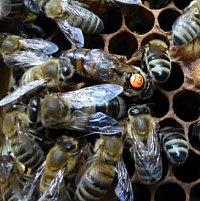Genetic caste determination of reproductive hierarchies in honeybees.
In eusocial insects like the honeybee the production of female offspring is restricted to the queen caste, whereas workers refrain from reproduction and fulfil all tasks neccessary for the maintainance of the colony. Evolution of that worker sterility can best be explained by kin selection, which is mainly governed by relatedness among colony members and by colony level selection, which is directed by the costs occurring when workers start to reproduce (Hammond and Keller, 2004). Caste determination in honeybees takes place at an early larval stage via differential nutrition. Nevertheless, apart from this proximate mechanism the detailed genetic architecture responsible for different reproductive fates still remains elusive.

To shed light on the genetic determination of reproductive hierarchies in honeybees we use both, different castes of the arrhenotokous subspecies Apis mellifera carnica and workers and pseudoqueens of the South-African Cape honeybees (Apis mellifera capensis). Cape honeybees are an evolutionary exception and therefore a promising model organism as they are able to undermine the queen´s reproductive monopoly and to establish themselves as fully reproductive "pseudoqueens" instead by a rapid ovarian development and by producing high amounts of the queenlike mandibular gland pheromone 9-ODA (9-oxy-decanoic acid). Moreover, worker of this subspecies have the unique ability to parthenogenetically produce female offspring (= thelytoky), due to an abnormal spindle rotation during meiosis. Previous studies in our lab were able to show that all of these reproductive traits are under control of a single recessive allele situated on chromosome 13 - the thelytoky-locus (Lattorff et al.; 2007). This locus was scanned for candidate genes and indeed a functional correlation between worker fertility and the alternative splicing of a gene that is homologous to the Drosophila transcription factor gemini and which is well situated within the thelytoky locus was found (Jarosch et al.; 2011). The actual mode of action will now be investigated using gene knock-down approaches. Furthermore, we are into unravelling the final genetic mechanisms of the thelytoky-phenomenon by analysing workers of A. m. capensis showing both modes of parthenogenesis. A genotyping by sequencing approach using RESTSeq will be applied here (Stolle and Moritz 2013).



